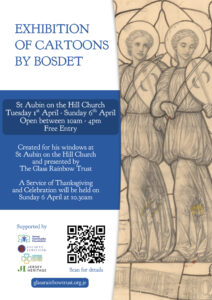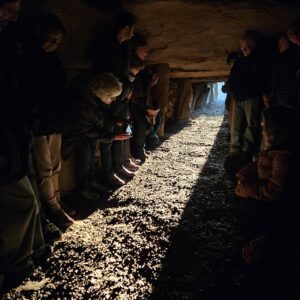
By Alasdair Crosby
Imagine this: you are in an aeroplane, probably a small one, doing a short journey from one regional airport to another, flying quite low over countryside that still retains to some degree, its typical and traditional local, rural physical features. Plymouth to Bristol might be one route, or maybe Lancaster to Carlisle.
For a more local route, imagine you are flying from Jersey to Caen, perhaps in the company of an official government delegation or with a twinning association, thinking mainly of a prospective vin d’honneur and a good lunch.
As you are flying not too high above – shall we say – the Devonshire, Cumbrian or Scottish Lowlands countryside, or maybe over the small hedged fields of the Côtentin, or the pastoral landscape of inland Brittany…. you pass through a cloud, or undergo a very slight bit of turbulence, that causes you no more than a few seconds’ anxiety. You emerge, and the flight continues just as before.
Unknown to you, your plane has passed through that doorway beloved of science fiction writers, a time warp, and you have emerged, 6,000 years in the past, in the Neolithic era. At this point, imagine as well, for the sake of building up an appropriately chilling atmosphere, the signature tune of that television series, The Twilight Zone.
As you sit comfortably, looking out of the window, it might be thought that immediately you emerged from that cloud or spot of mild turbulence, the change in the landscape below would be immediately noticeable: thick forest instead of green fields and farmed countryside.
In fact, quite some time might elapse before you noticed that anything was much amiss. There would still be familiar looking green fields, with livestock grazing, enclosed by stone walls or hedges, and small woods, individual or isolated homesteads, and small villages, separated, certainly, by some rough and wild ground, moorland or woodland, but certainly not by any vast extent of untamed wilderness – more Tolkien’s Shire than The Yukon Trail…
Only gradually do you realise that things are not quite as one might expect: the buildings are small and not symmetrically built; all the roofs are thatched; the tracks are not tarmacked; there is no glint of reflected sunshine on car bodywork; no housing estates. Only when these anomalies have registered over a period of time, do you also realise to your own increasing concern that there is no sign of an airport, and, in particular, no sign of an airport landing strip….
In Jersey circa 4,000 BC, according to a helpful notice at La Hougue Bie, there were only perhaps 3,000 inhabitants. Just imagine that magic and that glory: an empty interior of woods and isolated valleys, with fishing and farming hamlets dotted around the coast-line. Half-wild pigs rooting in the woodlands, small sheep and cattle grazing in the fields near the villages, the sound of grain being pounded in a quern, smoke rising from the thatch, fishing boats drawn up on the strand, the smell of curing meat and fish. Summer heat, winter darkness, spring lambing, harvest glut, the turning of the year from feast to fast, and on to feast again…
Inland, there would be mysterious and numinous places of worship, of which the major one was built in a rough tumulus shape that, in the then far future, would find its culmination in the shape of the pyramids of Egypt.
These musings are inspired by an announcement from Jersey Heritage that local poets are being invited to help to celebrate the 100th anniversary of the remarkable excavation of the Neolithic passage grave at La Hougue Bie.
Jersey Heritage and Société Jersiaise are asking poets to be inspired by the history, myths, stories and beliefs associated with the ancient site in Grouville and submit poems in English and/or Jèrriais for ‘A Celebration of Discovery at La Hougue Bie’. The selected poetry will be read at a special event being jointly organised by the two heritage organisations on 21 September to mark the centenary of the 10-day excavation in 1924 that unveiled the mysteries of the Neolithic passage grave to the world.
Jersey Heritage’s creative commissions producer, Aras Amiri, has said: ‘This milestone anniversary presents an opportunity to share the rich history of La Hougue Bie and the passage grave with Islanders and to encourage creative responses to its layered histories through the power of poetry.
‘We look forward to receiving creative contributions from local poets, or anyone inspired to write a poem, and to seeing how they use their words to help us to celebrate this historic event.’
The celebration event in September will include the opening of the art installation and talks, as well as readings of the selected poems. Each winning poem will be translated and recited in both English and Jèrriais.
After the event, the original poems will be shared on social media and printed copies will be available on-site for visitors. Poets will receive a commission payment of £100 for each selected poem. The deadline for submissions is 7 September.
Poems should be sent to aras.amiri@jerseyheritage.org with the subject line ‘La Hougue Bie Poetry Submission’.
A £100 fee will be paid after the selection process for selected poems. A shame, really, that although I enjoy hearing and reading poetry, I am not good at creating it, otherwise I might be after one of those £100 prizes for myself.
On several occasions in the past I have hauled myself out of bed in the small hours of an April morning to take myself to La Hougue Bie to observe the spring solstice. Most of those times, it was just a waste of valuable beauty sleep, as clouds obscured the early morning sunlight and my journey was for nothing. But on one or two occasions the early start was worthwhile indeed: magical in every sense of the word, to see the rosy spear of dawn sunlight glowing on the rocks at the far end of the chamber, the shaft widening and strengthening until it filled the width of the passageway, glowing on the floor pebbles, and impregnating the chamber with sunlight.
And when the glow withdrew again, we participants in this service followed it down the passage way and back outside, to where the surrounding fields were bathed in the bright sunshine of a spring morning – an event that might have appeared sacramental to the Island’s Neolithic population – and still seems sacramental in today’s modern and most unmagical of times.




